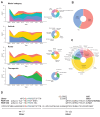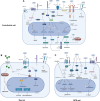Functional Roles of Pigment Epithelium-Derived Factor in Retinal Degenerative and Vascular Disorders: A Scoping Review
- PMID: 39728690
- PMCID: PMC11684118
- DOI: 10.1167/iovs.65.14.41
Functional Roles of Pigment Epithelium-Derived Factor in Retinal Degenerative and Vascular Disorders: A Scoping Review
Abstract
Purpose: This review explores the role of pigment epithelium-derived factor (PEDF) in retinal degenerative and vascular disorders and assesses its potential both as an adjunct to established vascular endothelial growth factor inhibiting treatments for retinal vascular diseases and as a neuroprotective therapeutic agent.
Methods: A comprehensive literature review was conducted, focusing on the neuroprotective and anti-angiogenic properties of PEDF. The review evaluated its effects on retinal health, its dysregulation in ocular disorders, and its therapeutic application in preclinical models. Advances in drug delivery, including gene therapy, were also examined.
Results: PEDF, initially identified for promoting neuronal differentiation, is also a potent endogenous angiogenesis inhibitor. Strong anti-angiogenic and neuroprotective effects are observed in preclinical studies. It has pro-apoptotic and antiproliferative effects on endothelial cells thereby reducing neovascularization. Although promising, clinical development is limited with only a single conducted phase I clinical trial for macular neovascularization. Development of PEDF-derived peptides enhances potency and specificity, and emerging gene therapy approaches offer sustained PEDF expression for long-term treatment. However, questions regarding dosage, durability, and efficacy remain, particularly in large animal models.
Conclusions: PEDF shows significant therapeutic potential in preclinical models of retinal degeneration and vascular disorders. Despite inconclusive evidence on PEDF downregulation as a primary disease driver, many studies highlight its therapeutic benefits and favorable safety profile. Advances in gene therapy could enable long-acting PEDF-based treatments, but further research is needed to optimize dosage and durability, potentially leading to clinical trials and expanding treatment options for retinal disorders.
Conflict of interest statement
Disclosure:
Figures




Similar articles
-
Polyethylene glycol-modified pigment epithelial-derived factor: new prospects for treatment of retinal neovascularization.J Pharmacol Exp Ther. 2012 Jul;342(1):131-9. doi: 10.1124/jpet.112.192575. Epub 2012 Apr 10. J Pharmacol Exp Ther. 2012. PMID: 22495066
-
Novel anti-angiogenic PEDF-derived small peptides mitigate choroidal neovascularization.Exp Eye Res. 2019 Nov;188:107798. doi: 10.1016/j.exer.2019.107798. Epub 2019 Sep 11. Exp Eye Res. 2019. PMID: 31520600 Free PMC article.
-
Pigment epithelium-derived factor reduces apoptosis and pro-inflammatory cytokine gene expression in a murine model of focal retinal degeneration.ASN Neuro. 2013 Nov 26;5(5):e00126. doi: 10.1042/AN20130028. ASN Neuro. 2013. PMID: 24160756 Free PMC article.
-
Pigment Epithelium-Derived Factor as a Possible Treatment Agent for Choroidal Neovascularization.Oxid Med Cell Longev. 2020 Mar 6;2020:8941057. doi: 10.1155/2020/8941057. eCollection 2020. Oxid Med Cell Longev. 2020. PMID: 32215180 Free PMC article. Review.
-
The role of PEDF in tumor growth and metastasis.Curr Mol Med. 2010 Apr;10(3):292-5. doi: 10.2174/156652410791065327. Curr Mol Med. 2010. PMID: 20236054 Review.
References
-
- Ciulla TA, Hussain RM, Taraborelli D, Pollack JS, Williams DF.. Longer-term anti-VEGF therapy outcomes in neovascular age-related macular degeneration, diabetic macular edema, and vein occlusion-related macular edema: clinical outcomes in 130 247 eyes. Ophthalmol Retina. 2022; 6: 796–806. - PubMed
-
- Askou AL, Jakobsen TS, Corydon TJ.. Retinal gene therapy: an eye-opener of the 21st century. Gene Ther. 2021; 28: 209–216. - PubMed
-
- Dawson DW, Volpert OV, Gillis P, et al. .. Pigment epithelium-derived factor: a potent inhibitor of angiogenesis. Science. 1999; 285: 245–248. - PubMed
-
- Tombran-Tink J, Chader GG, Johnson LV.. PEDF: a pigment epithelium-derived factor with potent neuronal differentiative activity. Exp Eye Res. 1991; 53: 411–414. - PubMed
Publication types
MeSH terms
Substances
LinkOut - more resources
Full Text Sources
Miscellaneous

